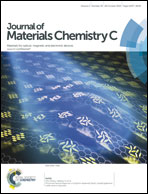Spontaneous in situ thermal growth of oriented acentric nanocrystals of [(E)-N,N-dimethylamino-N′-methylstilbazolium][p-toluenesulfonate] embedded in a PMMA film on ITO generating stable SHG†
Abstract
A poly(methyl methacrylate) (PMMA) composite film containing 4 wt% of the strongly second order NLO active ionic material [(E)-N,N-dimethylamino-N′-methylstilbazolium][p-toluenesulfonate] (DAST) deposited on an ITO substrate shows by a two step process (electric poling followed by controlled thermal annealing) a nonlinear optical coefficient d33 higher than the one obtained on a glass substrate. This higher value is the result of a polar order induced on the dye-doped polymeric film at the ITO–film interface, indicating that the polarity of the ITO surface is relevant in controlling the orientation process. By exploiting such induced polar order, oriented dipolar acentric nanocrystals of DAST can be grown in situ by solely and careful annealing, thus avoiding the detrimental effects often induced by the presence of a strong electric field. This leads not only to a spontaneous one step process of self-orientation but also to a better second order NLO response. In addition, different thermal pretreatments of ITO itself can induce different SHG responses from the DAST/PMMA films, the highest response being observed by preheating the ITO substrate at 370 °C for 24 hours.
![Graphical abstract: Spontaneous in situ thermal growth of oriented acentric nanocrystals of [(E)-N,N-dimethylamino-N′-methylstilbazolium][p-toluenesulfonate] embedded in a PMMA film on ITO generating stable SHG](/en/Image/Get?imageInfo.ImageType=GA&imageInfo.ImageIdentifier.ManuscriptID=C4TC01445F&imageInfo.ImageIdentifier.Year=2014)

 Please wait while we load your content...
Please wait while we load your content...